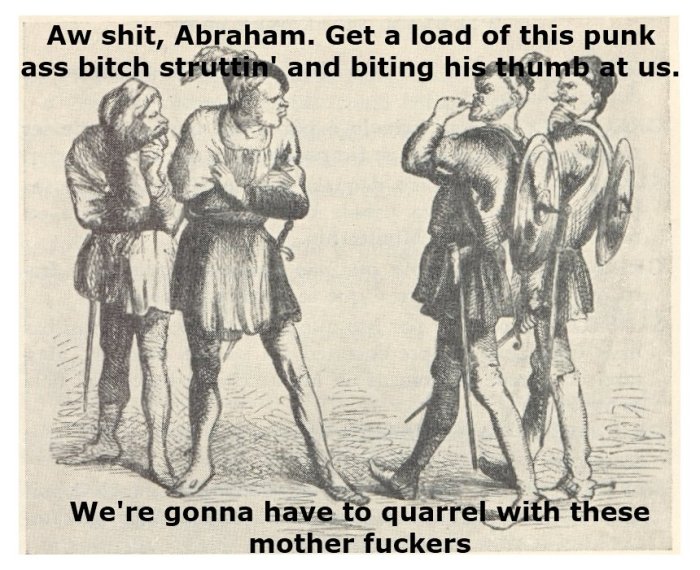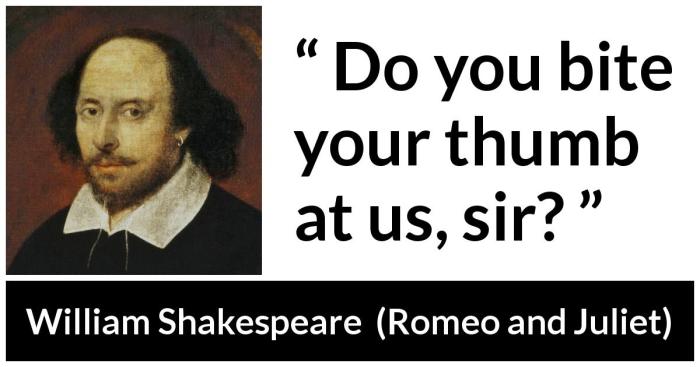Response to thumb biting in romeo and juliet – In William Shakespeare’s renowned tragedy Romeo and Juliet, the infamous thumb-biting scene holds immense significance, capturing the essence of Elizabethan society’s views on honor, violence, and the complexities of human nature. This exploration delves into the scene’s symbolism, its impact on the characters and plot, and its enduring relevance in understanding the play’s themes and motifs.
The thumb-biting scene, a moment of heated confrontation between Mercutio, Tybalt, and Romeo, serves as a catalyst for the tragic events that follow. Mercutio’s impulsive act of biting Tybalt’s thumb in response to his insults sets in motion a chain reaction of violence, leading to Mercutio’s untimely demise and Romeo’s banishment from Verona.
Introduction
In Shakespeare’s tragic masterpiece, Romeo and Juliet, the thumb-biting scene serves as a pivotal moment that foreshadows the impending violence and chaos that will engulf the play’s star-crossed lovers. This act, seemingly innocuous in isolation, becomes a potent symbol of the deep-seated animosity between the Montague and Capulet families.
Analysis of the Scene: Response To Thumb Biting In Romeo And Juliet

The thumb-biting scene occurs in Act I, Scene I, when Tybalt, Juliet’s fiery cousin, encounters Romeo, a Montague, at a masked ball. As tensions escalate, Tybalt challenges Romeo to a duel. However, Romeo, bound by his love for Juliet, refuses to fight.
This enrages Tybalt, who declares, “I will bite my thumb at them, which is a disgrace to them, if they bear it.” The act of thumb-biting, a gesture of extreme disrespect, is intended to provoke Romeo into a confrontation.
The symbolism of the thumb-biting is significant. The thumb is often associated with honor and authority, and by biting it, Tybalt is symbolically challenging Romeo’s manhood and his right to be present at the ball. This act foreshadows the inevitable bloodshed that will follow, as the two families are locked in a cycle of violence.
The consequences of the scene are far-reaching. Romeo’s refusal to fight angers Mercutio, his loyal friend, who steps in to defend him. In the ensuing duel, Mercutio is fatally wounded by Tybalt. This event triggers a chain reaction, leading to the deaths of both Romeo and Juliet.
Literary Devices

Shakespeare employs several literary devices in the thumb-biting scene to enhance its impact and significance.
- Foreshadowing:The scene serves as a clear foreshadowing of the violence that will later engulf the play’s characters. The act of thumb-biting suggests the impending conflict and the characters’ inability to resolve their differences peacefully.
- Irony:Romeo’s refusal to fight is ironic, given that he is a skilled swordsman. His reluctance to engage in violence stems from his love for Juliet, which ultimately leads to his downfall.
- Metaphor:The thumb-biting can be seen as a metaphor for the larger conflict between the Montagues and Capulets. The act of biting one’s thumb is a symbolic way of expressing anger and hostility, and it reflects the deep-seated animosity between the two families.
- Violence:The scene is a stark reminder of the play’s central theme of violence. The act of thumb-biting triggers a chain reaction that leads to the deaths of multiple characters, demonstrating the destructive power of unchecked aggression.
- Fate:The thumb-biting scene also highlights the role of fate in the play. Romeo’s refusal to fight Tybalt is not a matter of cowardice, but rather a result of his love for Juliet. This love, which is ultimately doomed, sets the characters on a path to tragedy.
- Honor:The concept of honor is central to the thumb-biting scene. Tybalt’s challenge to Romeo is based on his belief that Romeo’s presence at the ball is an insult to his family’s honor. Romeo’s refusal to fight is seen as a sign of weakness, but it is also an act of self-preservation.
Historical and Cultural Context

The thumb-biting scene must be understood within the historical and cultural context of Elizabethan England. During this period, honor was of paramount importance, and any perceived insult or slight could lead to a duel. Thumb-biting was a particularly provocative gesture, as it was considered a direct challenge to one’s manhood.
The scene also reflects the Elizabethan fascination with violence. Duels were a common form of entertainment, and the public often attended them with great relish. The thumb-biting scene taps into this fascination, while also foreshadowing the tragic consequences of unchecked aggression.
Adaptations and Interpretations
The thumb-biting scene has been interpreted and adapted in various stage and film productions. Some directors have chosen to emphasize the scene’s comedic aspects, while others have focused on its darker implications.
In the 1968 film adaptation directed by Franco Zeffirelli, the scene is played for laughs, with Tybalt’s thumb-biting accompanied by a slapstick sound effect. This interpretation highlights the absurdity of the feud between the Montagues and Capulets.
In contrast, the 1996 film adaptation directed by Baz Luhrmann presents the scene as a more serious and violent affair. Tybalt’s thumb-biting is depicted as a calculated provocation, and the ensuing duel is bloody and brutal. This interpretation emphasizes the tragic consequences of unchecked aggression.
Themes and Motifs

The thumb-biting scene embodies several key themes and motifs that run throughout Romeo and Juliet.
Answers to Common Questions
What is the significance of the thumb-biting scene in Romeo and Juliet?
The thumb-biting scene is a pivotal moment that sets in motion the tragic events of the play. It represents the impulsive and violent nature of Elizabethan society and the consequences of honor-driven conflicts.
How does the thumb-biting scene contribute to the characterization of Mercutio?
The scene reveals Mercutio’s hot-headed and impulsive nature. His act of thumb-biting is a manifestation of his pride and his willingness to defend his honor, even at the cost of his own life.
What is the symbolism behind the thumb-biting gesture?
The thumb-biting gesture is a sign of contempt and insult. It is a way of expressing one’s disdain for another person and their actions.